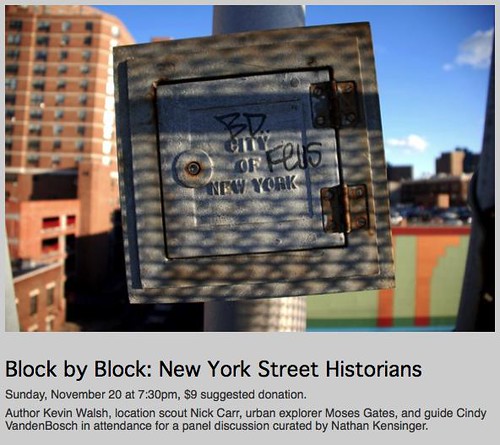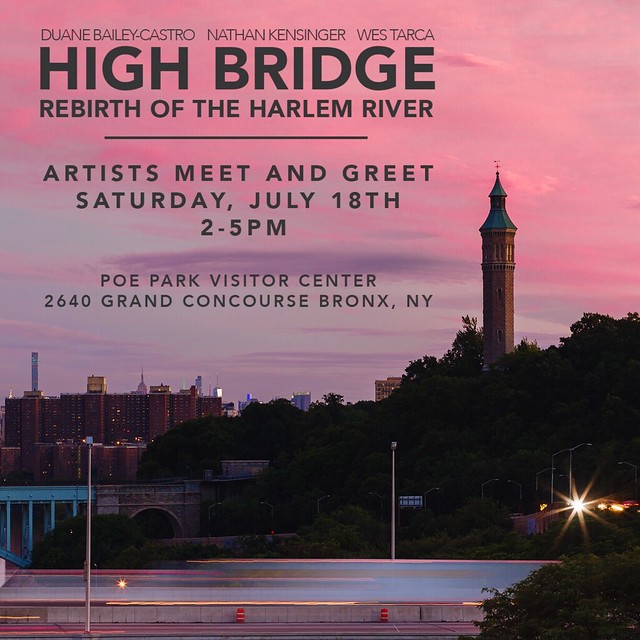Bloomfield, Staten Island

The Abandoned & Industrial Edges of New York City

posted by Nathan Kensinger 7 comments

In December 2011, one of my photographs was selected for Curate NYC, "a juried exhibition and online platform that exists to heighten exposure and opportunities for New York City visual artists." Over 1,500 New York artists submitted work for this competition. The top 150 entries were selected by a panel of judges and exhibited at the Rush Arts Gallery in Manhattan. My entry was a photograph titled "A Kissproof World" (2009), which was from a series taken underneath the Coney Island boardwalk. It was exhibited at the Rush Arts Gallery from December 1st-10th, and was also selected for an online gallery by the Deep Tanks Studio in Staten Island.
More information on Curate NYC can be seen at their website.
posted by Nathan Kensinger 0 comments

On Sunday, November 20th, 2011, I curated an event titled "Block By Block: New York Street Historians" at UnionDocs, the documentary collaborative in Williamsburg, Brooklyn. The event was a panel discussion with several "street historians" who are creatively exploring and documenting the city - author Kevin Walsh of Forgotten New York, location scout Nick Carr of Scouting New York, urban explorer Moses Gates of All City New York, and tour guide Cindy VandenBosch of Urban Oyster. "Block by Block" was featured in the Wall Street Journal, Urban Omnibus, and the Brooklyn Paper, and in an article I wrote for PBS 13 WNET's website, MetroFocus. The event was part of a series of UnionDocs panels I am curating - the first, from April 2011, was "Down the Road: Modern New York Street Photographers." More information can be seen at the UnionDocs website.
The following is from my description of "Block By Block":
"In a city as vast as New York, there is always a story waiting to be told, a block waiting to be walked, a building with an unwritten history. Over the past decade, many New Yorkers have been creatively documenting the changing streets of the city on websites and blogs. Often, these modern day storytellers are not historians or authors by training. Their work is part of a tradition of “unofficial,” “informal,” “underground,” and “alternative” histories of New York City. However, after walking through the city block by block, a better title for their work could be “street history.”
The modern New York City street historian can be traced back to George G. Foster, a reporter who explored 1800′s New York as it grew from a town into a modern metropolis. His seminal work, “New York By Gas Light” (1850), is considered a groundbreaking example of urban non-fiction, and presented “the under-ground story – of life in New York,” with portraits of “the festivities of prostitution, the orgies of pauperism, the haunts of theft and murder, the scenes of drunkenness and beastly debauch.”
Foster’s candid explorations of New York’s streetscapes directly influenced the work of many writers in the 1900′s, including Joseph Mitchell – The New Yorker magazine’s “poet of the waterfront,” Herbert Asbury – a reporter who penned a series of “informal” New York histories including “The Gangs of New York,” and Meyer Berger – a Pulitzer Prize winning journalist and “incurable New Yorker” whose colorful New York portraits were published in several collections.
In the same era, several New York street historians physically embraced the challenge of exploring modern New York. For his magnum opus, “History in Asphalt” (1978), amateur historian John McNamara walked, biked or canoed every street in the Bronx, creating an exhaustive encyclopedia of street and place names. His peers include Commander Thomas J. Keane, who completed his walk of every street on Manhattan Island in 1954. Unfortunately, Keane did not keep a diary, but in the next century, Robert Jay Kaufman did, writing “Blockology: An Offbeat Walking Guide to Lower Manhattan” (2005), after walking the 1,544 blocks below 14th Street, a distance of about 300 miles.
Today’s panel brings together four active New York City street historians – a guide, an author, an urban explorer, and a location scout – who are tirelessly exploring the 21st century city, block by block, on their own unique paths - Nathan Kensinger, curator"
posted by Nathan Kensinger 0 comments

On November 8th, 2011, The North Brooklyn Public Art Coalition (nbART) announced the selection of its sixth public art project, The Newtown Creek Armada, an interactive installation in which a model boat pond will be created on the Newtown Creek, one of America's most polluted waterways. The Newtown Creek Armada is a collaboration between myself and two other Brooklyn artists - Laura Chipley and Sarah Nelson Wright - whose work also explores industry, ecology, and change in urban spaces. The project was created in response to nbECO 2012, an open call seeking environmentally and sustainability conscious art installations.
The Newtown Creek Armada will be launched in Fall 2012, when visitors will be invited to pilot a fleet of artist-created, miniature, radio-controlled boats along the Newtown Creek's surface, while at the same time documenting the world hidden beneath the water. Each boat in The Armada will be equipped with a waterproof camera, allowing participants to record a unique voyage on and under the creek. Video from these underwater explorations will be on view at the creek, giving visitors a chance to virtually immerse themselves in the toxic waters of this Superfund site. In 2013, the archive of voyages from The Armada will be presented in an immersive gallery installation.
posted by Nathan Kensinger 0 comments

October 31st, 2011 - This photo essay is excerpted from a lecture & slideshow I presented at Cabinet Space on October 8th, 2011 titled "Gowanus Canal: Toxic Playground," which was part of Gowanderlust, my nighttime walking tour of the Gowanus Canal organized by Cinebeasts. For a description and photos from Gowanderlust, read the Urban Omnibus writeup.
For the past several decades, the Gowanus Canal has been a center of unrestricted creativity in Brooklyn. With seemingly few rules or regulations, the canal area became a source of inspiration to numerous artists, filmmakers and photographers. Bohemian communities developed on its waters, including a houseboat armada and the now-defunct Batcave. Its empty lots, once described as "Brooklyn's biggest toxic playground" by Robert Guskind, were taken over by graffiti artists, sculptors, and homeless camps. Arts groups and gallery spaces, including Rooftop Films and Issue Project Room, found homes in its industrial buildings. Creative projects like the Dumpster Pools were installed on its banks, while community groups like the Gowanus Dredgers organized access to its waters.
However, the darker side of the canal's lawlessness includes more than a century of criminal dumping. As chronicled in Allison Prete's documentary "Lavender Lake: Brooklyn's Gowanus Canal" (1999), the canal has long been "an open sewer" for the surrounding communities, in the fecal sense and in other ways. The canal was completed in 1869, according to the Environmental Protection Agency, and industries along its shores have been poisoning its waters ever since. At one point, according to stories, the pollution was so bad that the canal was prone to spontaneous combustion. It was also a reputed Mafia dumping ground, with neighbors finding dead bodies in the water, sometimes tied to chairs. In 2010, the canal was Superfunded, with the EPA labelling it "one of the nation's most extensively contaminated water bodies."
posted by Nathan Kensinger 1 comments
 October 19, 2011 -
October 19, 2011 -
From October 21st 2011 to January 2012, a selection of my photographs will be exhibited at the 92Y Tribeca. The exhibit, part of the 3rd annual Doomsday Film Festival and Symposium, "brings together a wide variety of artists who have created work inspired by the idea of an Apocalypse." My photographs will explore the post-apocalyptic landscape, with images of devastation from across New York City.
The selected photographs capture the ruins of a once thriving industrial empire, the remains of neighborhoods that have been destroyed and wiped off the map, abandoned military bases and civic structures, toxic environmental wastelands, and the unstoppable return of nature to desolate areas where humans once lived. They include the photograph featured above, from the South Edgemere Wasteland, a New York City neighborhood which was destroyed over 35 years ago during an economic and social crisis, and which has since become a beachfront wilderness populated by homeless encampments and marauding wild dog packs.
The exhibit will open on Friday, October 21st with a reception from 6-8pm. For more information, please visit the 92Y Tribeca.
posted by Nathan Kensinger 2 comments

On October 1st 2011, my photographs from inside the Greenpoint Terminal Market were projected onto the exterior of this warehouse complex in a site-specific installation titled "The Forgotten City." The piece took viewers through the hidden rooms and passages of these warehouses with a series of photographs taken between 2007 and 2011. The piece detailed the history of these buildings, which date back to 1890, and included stories of riots, explosions, fires and squatters. "The Forgotten City" was inspired by my original photo essay, "The Greenpoint Terminal Market Revisited," which was published on this website in November 2010.
This installation was a part of Bring To Light, an outdoor nighttime art festival of light-based video, sculpture and installations on the Greenpoint waterfront. Bring To Light included over 50 artists from around the world, "some of the established auteurs of this artistic genre... and a long list of emerging talent," according to Urban Omnibus. "The Omnibus team, proud civic partner of the event, is particularly excited to check out... the industrial photography of Nathan Kensinger."
Brooklyn Based wrote of the event "photographer Nathan Kensinger has a... interesting project planned for Bring To Light. He’s been taking photos along Greenpoint’s waterfront for years, and will be projecting images that he’s captured of the inside of the Greenpoint Terminal Market onto the side of one of its buildings tomorrow. 'The photographs were taken over the past five years, and will be presented along with the story of the buildings, which date back to 1890,' Kensinger wrote... 'They have a long, dark history: a century ago, a thousand workers rioted in the streets in front of the Greenpoint Terminal Market, in the same streets where Bring To Light will take place.'"
For more information, visit Bring To Light's website: www.bringtolightnyc.org. The following are several photographs documenting the installation.
posted by Nathan Kensinger 0 comments





